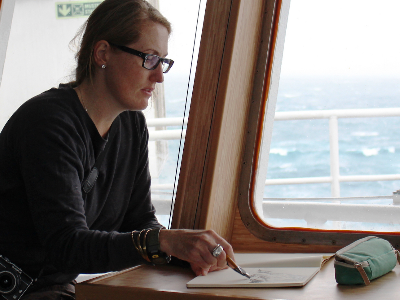July 27, 2016
Seafloor mapping comes alive through art this month during ‘Oceans of the Unknown’, an exhibition at the Institute for Marine and Antarctic Studies on Hobart’s waterfront.
Part of National Science Week, the exhibition is funded by a University of Tasmania Cross Disciplinary Incentive Grant, with support from the Marine Biodiversity Hub. It features works by artists Jan Hogan and Annalise Rees from the Tasmanian College of the Arts, and Hub spatial analyst Vanessa Lucieer whose work contributes to our understanding of what lies in Australia's new Commonwealth Marine Reserve network.
When
2 to 31 August 2016
5 August - Opening of exhibition, 5 pm (by invitation)
19 August - Floor talk 2.30 to 3.30 pm
Where
Institute for Marine and Antarctic Studies Exhibition space
20 Castray Esplanade, Battery Point, Tasmania
<iframe src="https://www.facebook.com/plugins/video.php?href=https%3A%2F%2Fwww.facebo... width="560" height="315" style="border:none;overflow:hidden" scrolling="no" frameborder="0" allowTransparency="true" allowFullScreen="true"></iframe>

Watch the animation - mapping oceans of the unknown
How do you create an image of something unseen?
Vanessa Lucieer's videos, models, etchings, sculptures and prints draw from her acoustic data and engineering plans, and her armada of tiny porcelain ships communicates the challenge of defining Australia’s ocean habitats. Jan Hogan's prints were created in the environment of the Derwent, her inks and papers transformed by salt water contact, and Annalise Rees's drawings were done onboard the Marine National Facility RV Investigator. Together the artworks explore the use of line and image to communicate ideas about the unseen.
‘Our efforts to define the ocean test our ability to capture data using sound, vision or light with robotic technologies that spread our sensory reach hundreds or thousands of meters below the surface,’ Vanessa says. ‘I use these data to draw seafloor landscapes, often revealing their contours and structure for the first time. I try to see what the patterns of seafloor shapes and textures can tell me about the habitats and lifeforms they embrace.’
Vanessa says a perpetual challenge is to understand the scale of mapping required for this relationship between the seafloor and its biology to come into focus. To explore this challenge, each of her artworks plays on the concept of scale.
The ‘Kerguelen Kaleidoscope’ lends a riot of colour to divinely shaped seafloor features that emerge at different magnifications: some up close, others far away. ‘Tiny Captains in Southern Ice’ are made so small to visualise the immensity of its mission to collect ocean data. The 3-D printed models of robotic underwater vehicles highlight our growing capacity to sample the seafloor in finer detail than has ever been possible beyond depths reached by divers.
‘Through my artworks I have tried to show how complex, dynamic and unique this environment can be,’ Vanessa says. ‘Each artwork has accompanying text, video or graphics to put the work into a scientific context and answer an important question. Why is collecting this data important for society?’

Image top right: Data flows. Jan Hogan, Tasmanian College of the Arts
Above centre: Artist Annalise Rees finds inspiration at sea during her voyage aboard the RV Investigator.
Above: The Kerguelen Kaleidescope lends a riot of colour to seafloor features. Vanessa Lucieer, IMAS.
- Log in to post comments
